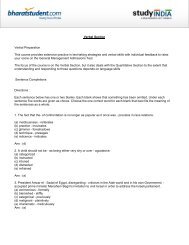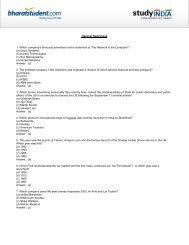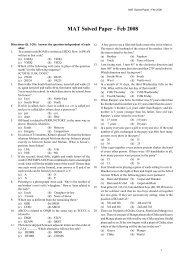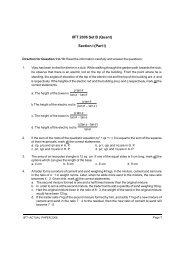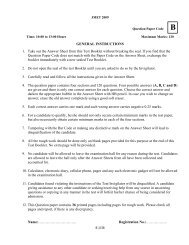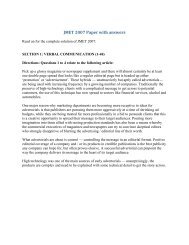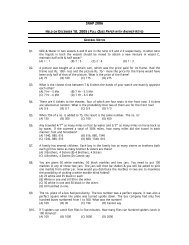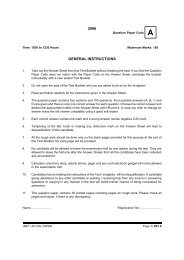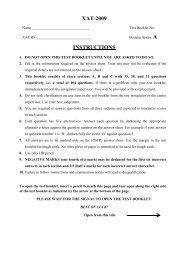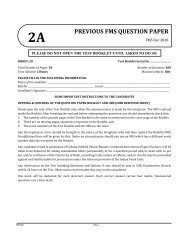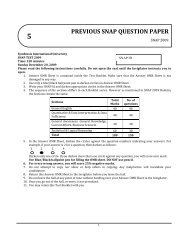SERIES 11 Test Booklet Serial No - Bharatstudent.com
SERIES 11 Test Booklet Serial No - Bharatstudent.com
SERIES 11 Test Booklet Serial No - Bharatstudent.com
Create successful ePaper yourself
Turn your PDF publications into a flip-book with our unique Google optimized e-Paper software.
Passage 1 (Q. 99-105):<br />
Section 3 (35 Questions)<br />
The driving force of evolution, according to the emerging new theory, is not to be found in the<br />
chance events of random mutations but in life's inherent tendency to create novelty, in the<br />
spontaneous emergence of increasing <strong>com</strong>plexity and order. Once this fundamental new insight<br />
has been understood, we can then ask: What are the avenues in which evolution's creativity<br />
expresses itself?<br />
The answer to this question <strong>com</strong>es not only from molecular biology but also, and even more<br />
importantly, from microbiology, from the study of the planetary web of the myriads of microorganisms<br />
that were the only forms of life during the first two billion years of evolution. During<br />
those two billion years, bacteria continually transformed the Earth's surface and atmosphere and, in<br />
so doing, invented all of life's essential biotechnologies, including fermentation, photosynthesis,<br />
nitrogen fixation, respiration, and rotary devices for rapid motion.<br />
During the past three decades, extensive research in microbiology has revealed three major<br />
avenues of evolution. The first, but least important, is the random mutation of genes, the<br />
centerpiece of neo-Darwinian theory. Gene mutation is caused by a chance error in the selfreplication<br />
of DNA, when the two chains of the DNA's double helix separate and each of them<br />
serves as a template for the construction of a new <strong>com</strong>plementary chain.<br />
It has been estimated that those chance errors occur at a rate of about one per several hundred<br />
million cells in each generation. This frequency does not seem to be sufficient to explain the<br />
evolution of the great diversity of life forms, given the well-known fact that most mutations are<br />
harmful, and only very few result in useful variations.<br />
In the case of bacteria the situation is different, because bacterium divides so rapidly. Fast bacteria<br />
can divide about every twenty minutes, so that in principle several billion individual bacteria can<br />
be generated from a single cell in less than a day. Because of this enormous' rate of reproduction, a<br />
single successful bacterial mutant can spread rapidly through its environment, and mutation is<br />
indeed an important evolutionary avenue for bacteria.<br />
However, bacteria have developed a second avenue of evolutionary creativity that is vastly more<br />
effective than random mutation. They freely pass hereditary traits from one to another in a global<br />
exchange network of incredible power and efficiency. Here is how Lynn Margulis and Dorion<br />
Sagan describe it:<br />
Over the past fifty years or so, scientists have observed that [bacteria] routinely<br />
and rapidly transfer different bits of genetic material to other individuals. Each<br />
bacterium at any given time has the use of accessory genes, visiting from<br />
sometimes very different strains, which perform functions that its own DNA may<br />
not cover. Some of the genetic bits are re<strong>com</strong>bined with the cell's native genes;<br />
others are passed on again. As a result of this ability, all the world's bacteria



